September 2023, Borneo Indonesia
(Excerpts from our instagram posts)
For the past ten years there’s a place, there’s a trip, there’s an adventure we’ve been yearning to experience!
It was either too expensive, or requiring time and energy we didn’t have, so time and again it evaded us…
But the stars are aligned and the full blue moon has delivered a path for us to finally concretize this undertaking.
We are suddenly busy getting ready for a big adventure, which begins in a few days!
This adventure incorporates everything we are passionate about :
* Environmental initiatives to counter destruction of primal ancestral forest
* Conservation efforts to protect endangered wildlife
* Communities on the frontline finding and implementing solutions to have positive environmental and biodiversity impact
We will be taking 2 short plane rides from Bali to get to Borneo.
We will be traveling up river through the deep jungle of Borneo on a wooden boat. We will be living and sleeping on the boat for four days.
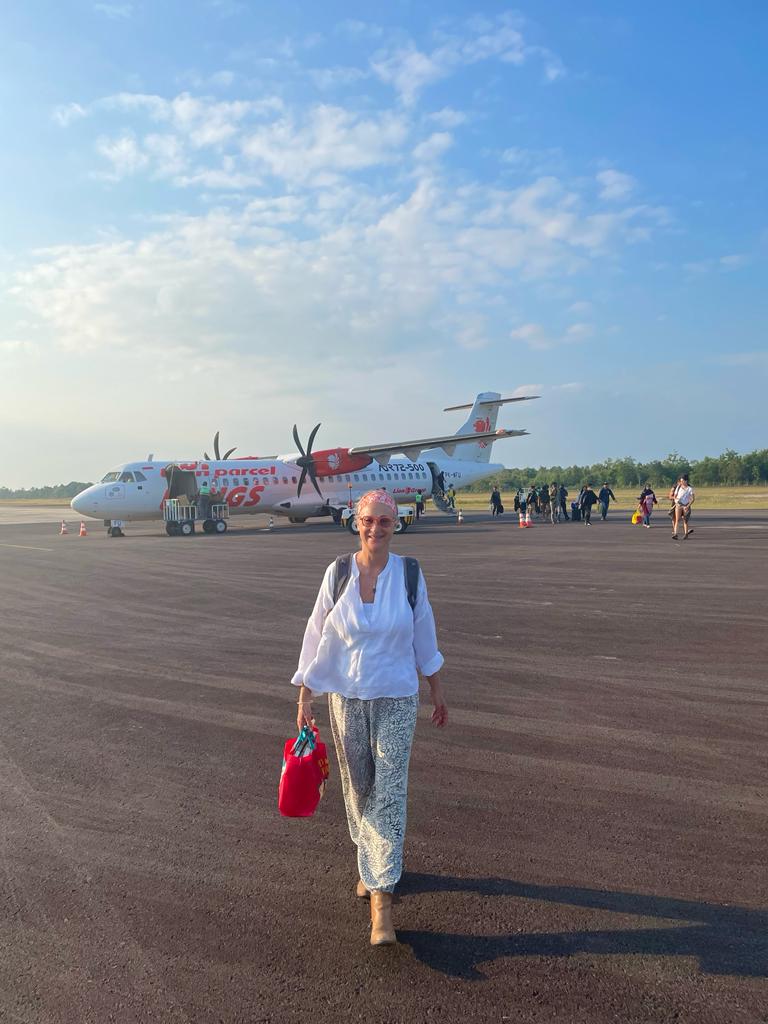
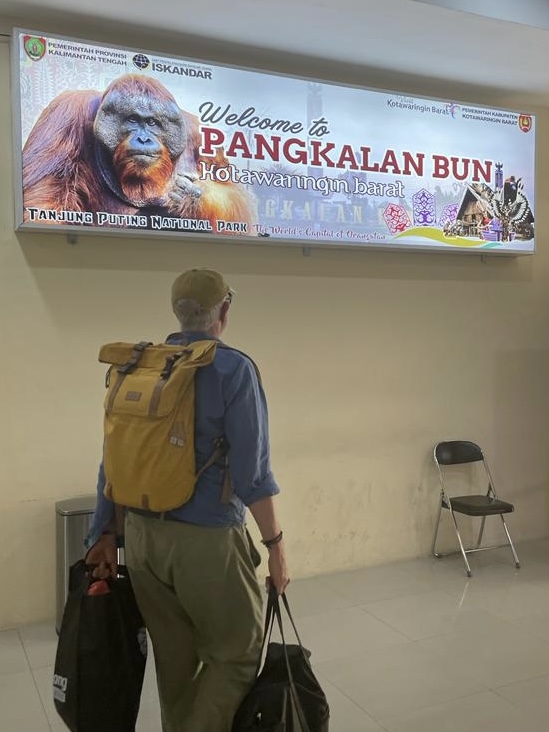
We will be hiking through the jungle to hopefully encounter wild orangutans of Borneo, in what’s left of their natural habitat. We will also visit 3 conservation sites which are focused on rescue and release efforts.
We hope to gain an understanding of the complexity of the situation on the ground whereby palm oil producers continue to encroach on the dwindling forests of Borneo.
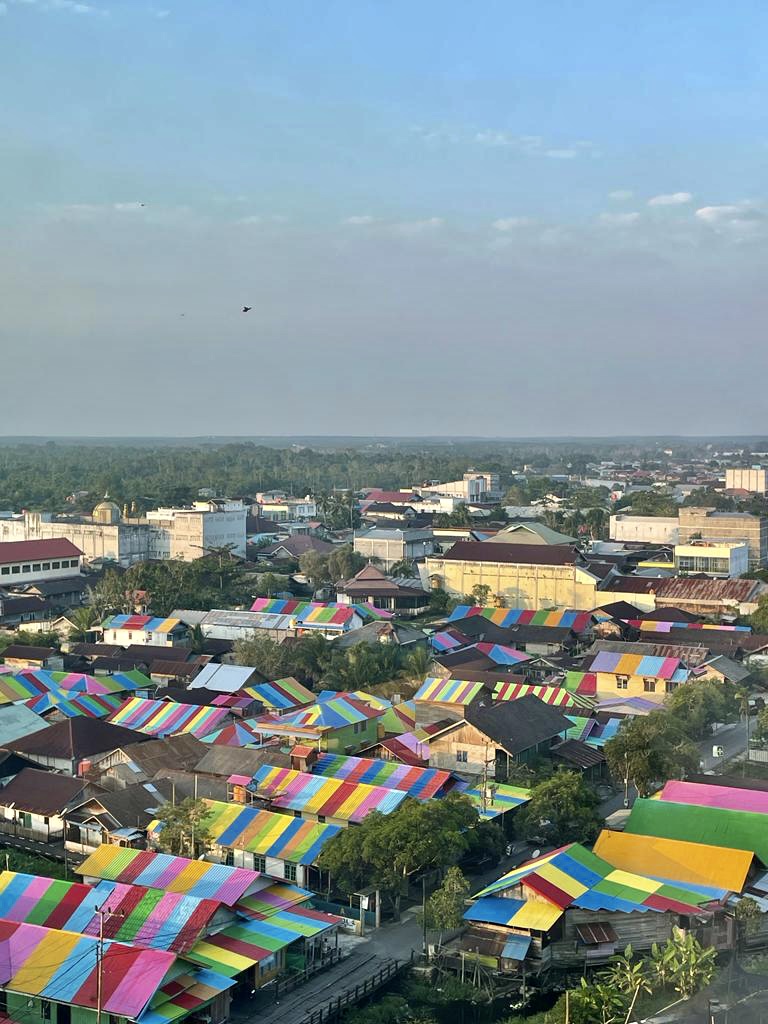
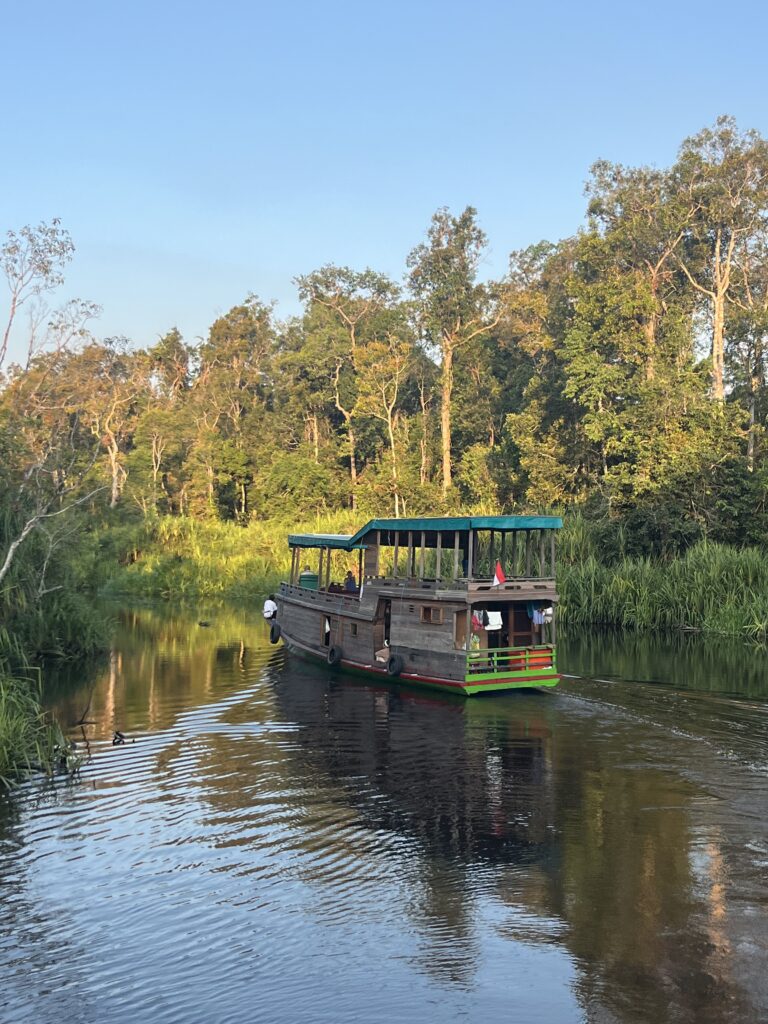
Called a “kloptok”, for the sound it makes as it slowly chugs along the winding river, through the rain forest and jungle of Kalimantan, Borneo, this old fashioned wooden boat is our home for the next few days.
We opt to sleep on the open air platform, (rather than the bedroom below deck) to enjoy the magical night sky, alive with the brightest stars, the fresh air and nature’s abundance of night sounds.
For a short video showing us moving leisurely through the river, please click the link below.
https://www.youtube.com/shorts/qYCpVFvNdgA
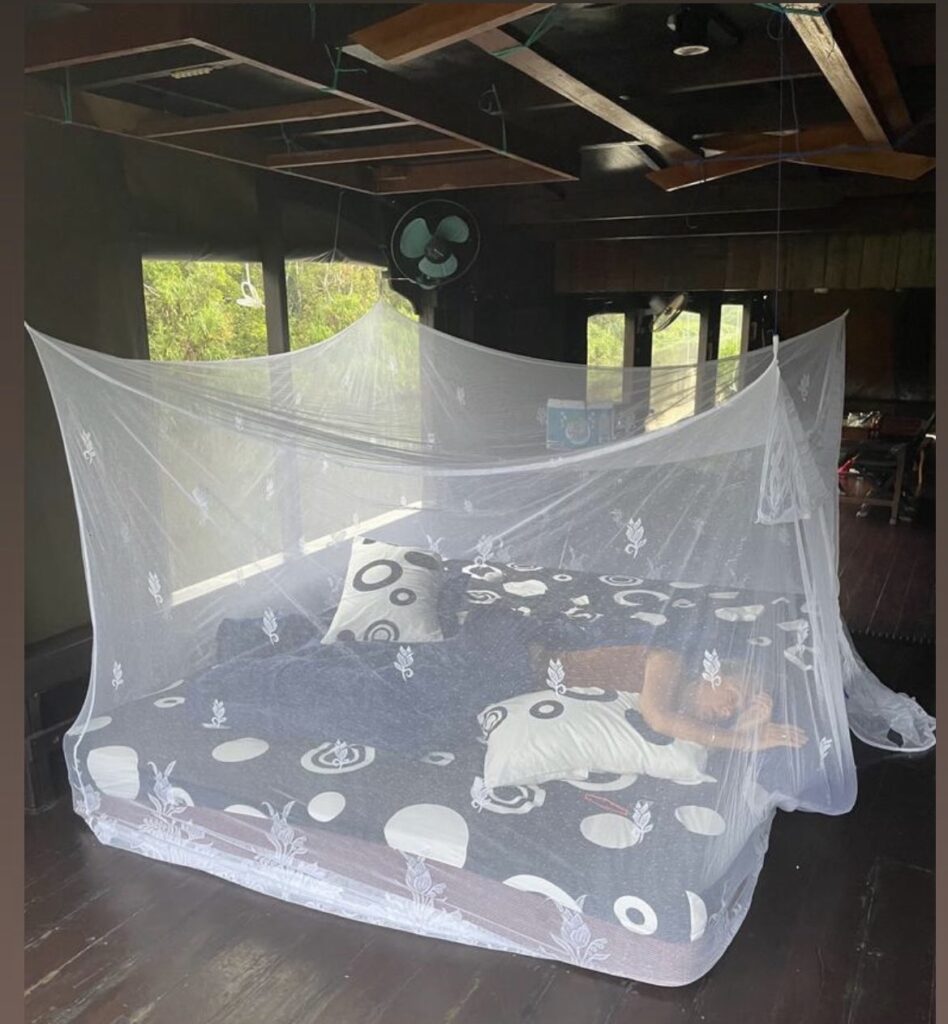
By 5 a.m it’s like a curtain slowly lifts, as night gives way to the soft colors of dawn and a chorus of bird songs.
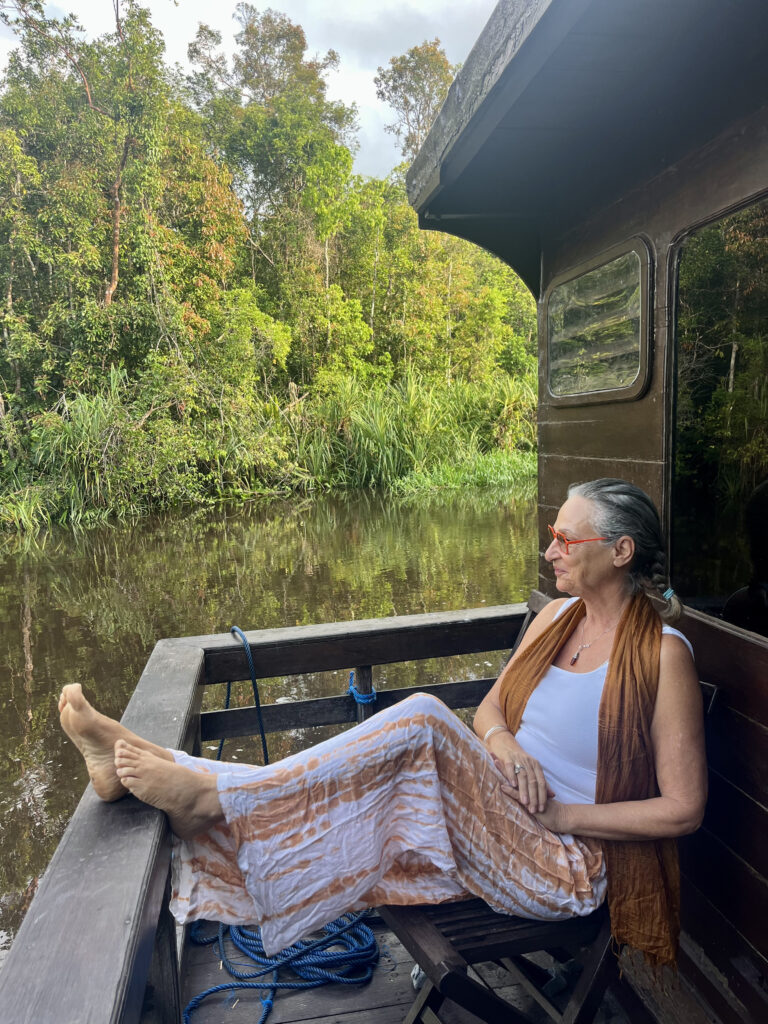
We relish the slow pace of the boat as the scenery is continuously changing, as the river narrows and we snake slowly through the rainforest getting deeper into the jungle of Borneo.
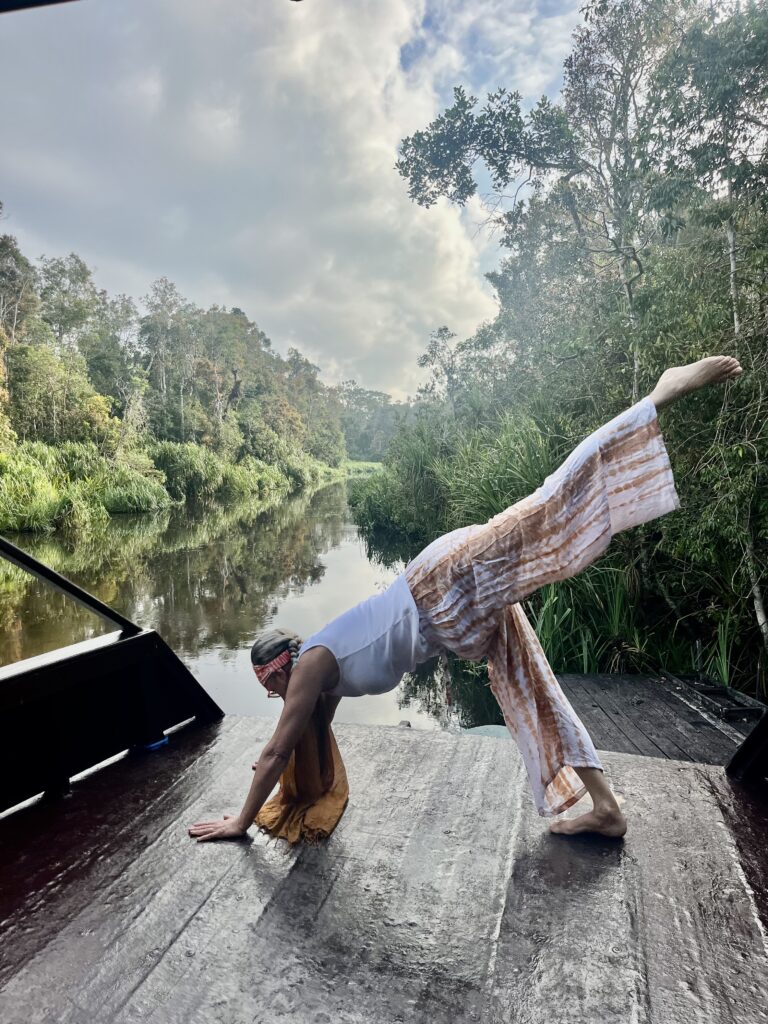
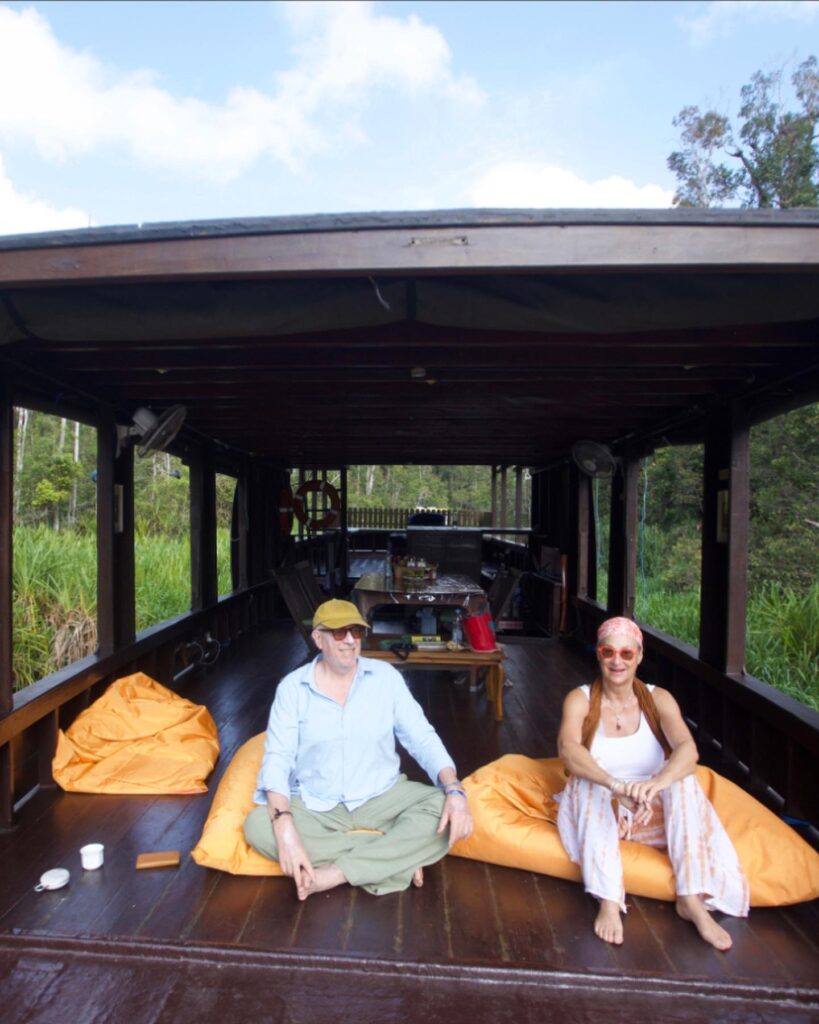
You wouldn’t know from being on the kloptok boat that the once pristine forest around us, which is the natural habitat for the now endangered orangutans, is under continued attack by palm oil producers. Over 50% of the Bornean rain forest has been destroyed over the last 40 years. A shocking reality given that the Bornean rainforest is estimated to be a 140 million years old ~ making it the oldest rainforest in the world.
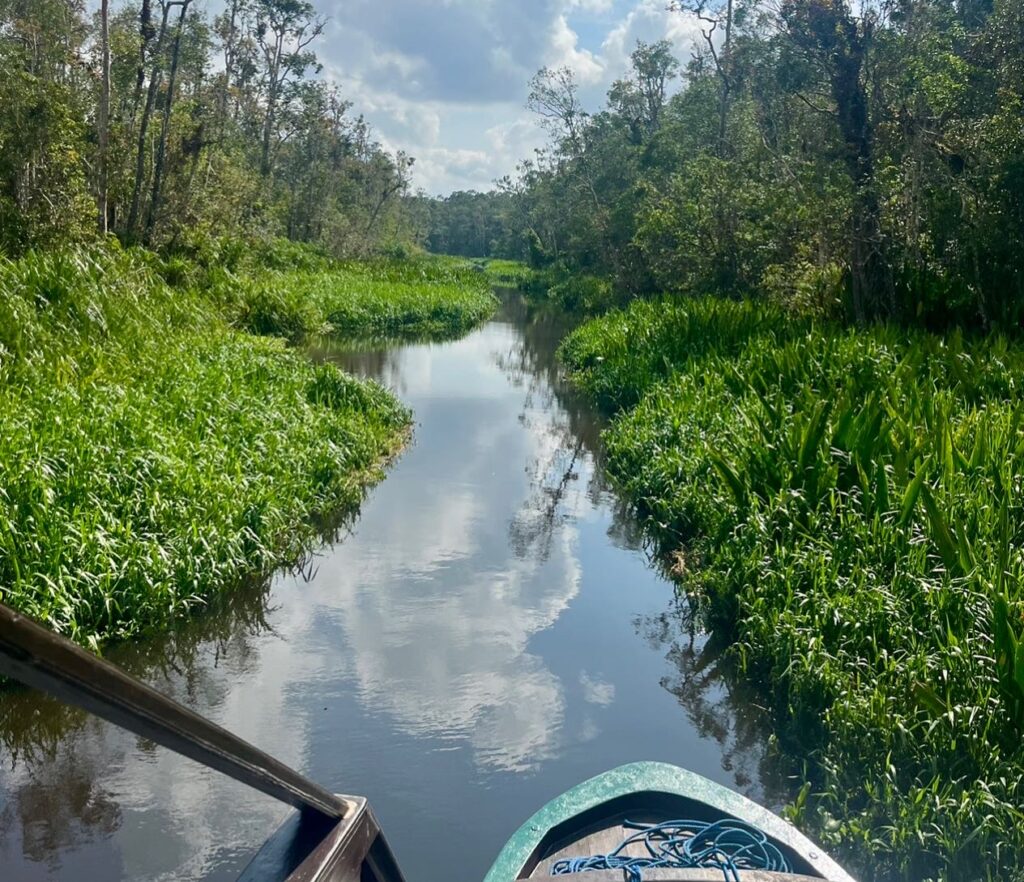
This is a tragic trajectory which points to the inevitable disappearance of orangutans in the next 50 years. Every year the loss of habitat results in the reduction of orangutan population by 3,000. (8 orangutans die every day).
It’s not just orangutans that are victims of the deforestation caused by palm oil producers, but the entire ecosystem with its uniquely large biodiversity of fauna and flora.
We witness trees heavy with Probiscis monkeys with their unusual noses and myriad of strange monkey calls. We see Macaque monkeys, gibbons, brightly colored kingfishers and eagles from the deck of the kloptok.
~~
Our first sighting of an orangutan is when a HUGE male descends literally right in front of us, from the canopy of branches above. His sheer size and height is surprising and his presence is majestic.
He is the dominant male of the group and his presence signals to the others that it’s safe to descend.
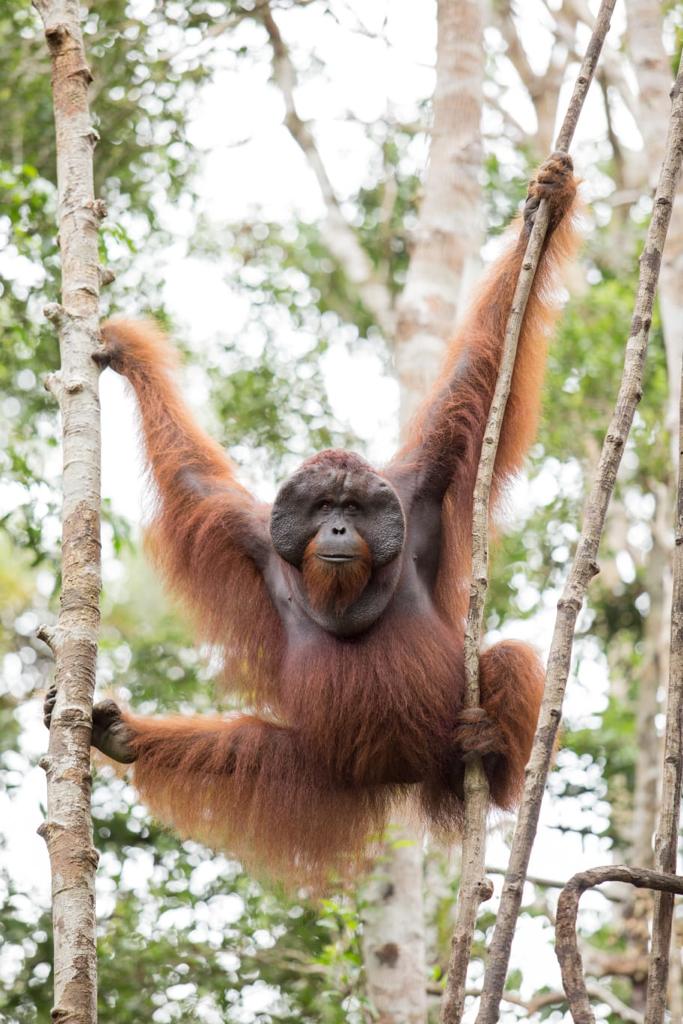
We are at a feeding station for orangutans and once the dominant male has seated himself on the platform, mothers start to approach with babies clinging casually to their sides or backs.
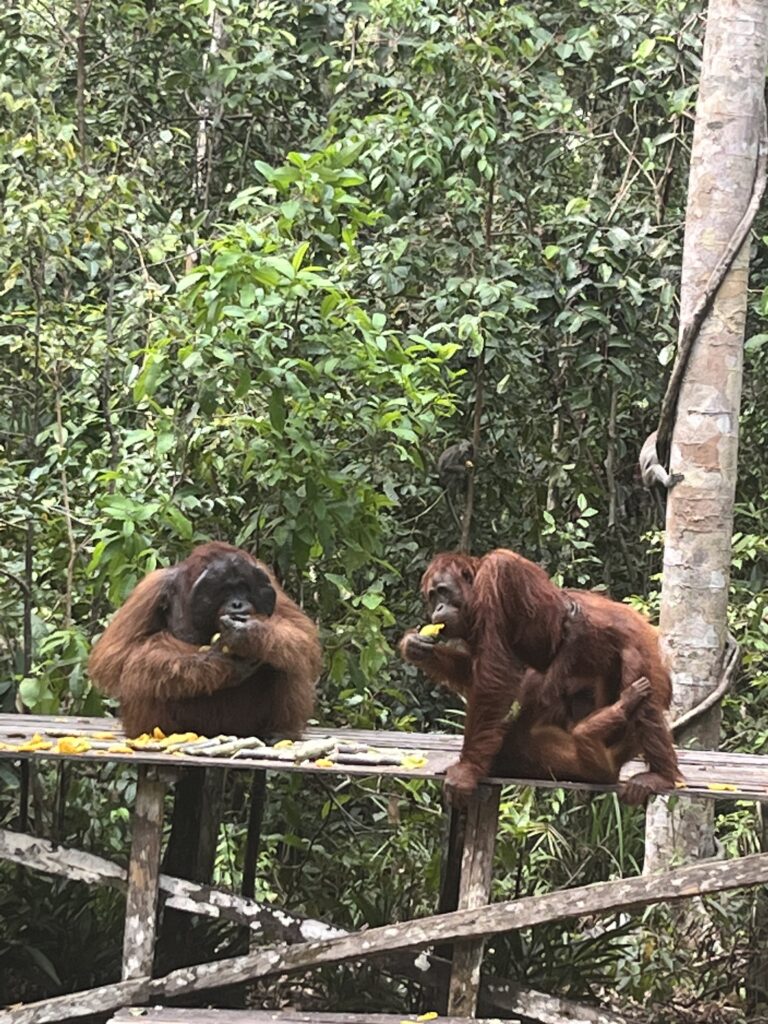
Our excitement as these magnificent creatures start to come into view is indescribable. The sound of branches swaying and rustling signals that orangutans are around and above us!
While the young orangutans have a distinctive mango colored fur, the adults fur is a deep chocolate brown color.
Short video: large male at a feeding station: https://youtube.com/shorts/v6Dj5naF3ew?feature=share
Short video of largest male monopolizing food: https://youtube.com/shorts/ViQizxvCV9Y?feature=share
Adult Orangutans have arm wing spans of 7 feet wide. Their feet function as additional hands. Because they use all 4 limbs to climb, they carry the sugar cane pieces in their mouths, like large cigars. Orangutans DNA is 98% the same as humans. Watching them ascend and descend is like watching the most skilled, very large acrobats
The feeding stations serve to augment their diet, especially when fruits are less abundant. The majority of orangutans who come for food are ones that have spent time at the rescue center.
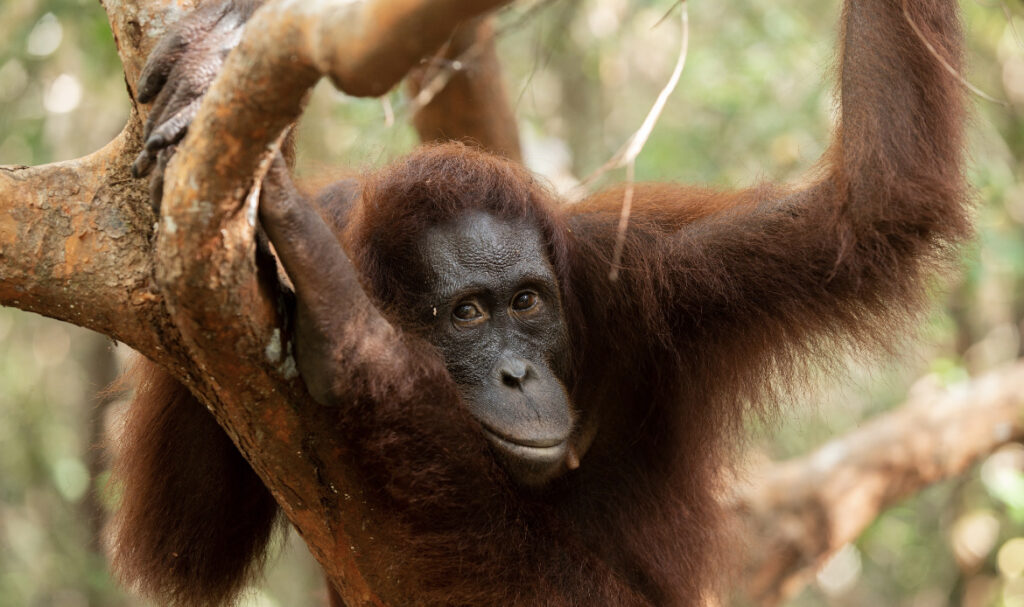
There are 3 sub species of orangutans. One has its natural habitat here in Kalimantan, one on the Malaysian side of Borneo and one on the Indonesian island of Sumatra. Tragically the Sumatran orangutan has been decimated and there are only 800 left (in the world). Their extinction is imminent.
Human consumption of palm oil is the culprit.
What we can do is we can read labels and not purchase products containing palm oil.
Palm oil is in close to 50% of the packaged products we find in supermarkets ~ everything from pizza, Nutella, doughnuts and chocolate, to deodorant, shampoo, toothpaste and lipstick. It’s also used in animal feed and as a biofuel in many parts of the world.
The 3rd camp and feeding station of orangutans ends our adventure in Borneo’s rainforest with a bang!
We’ve seen them from the boat and while walking through the forest, but at this last feeding station they came out in force. We are exhausted from both the excitement and craning our heads up to the tree tops to watch them as descend, swing and stretch laterally from trunk to tree trunk and hang from one or more limbs in mid air.
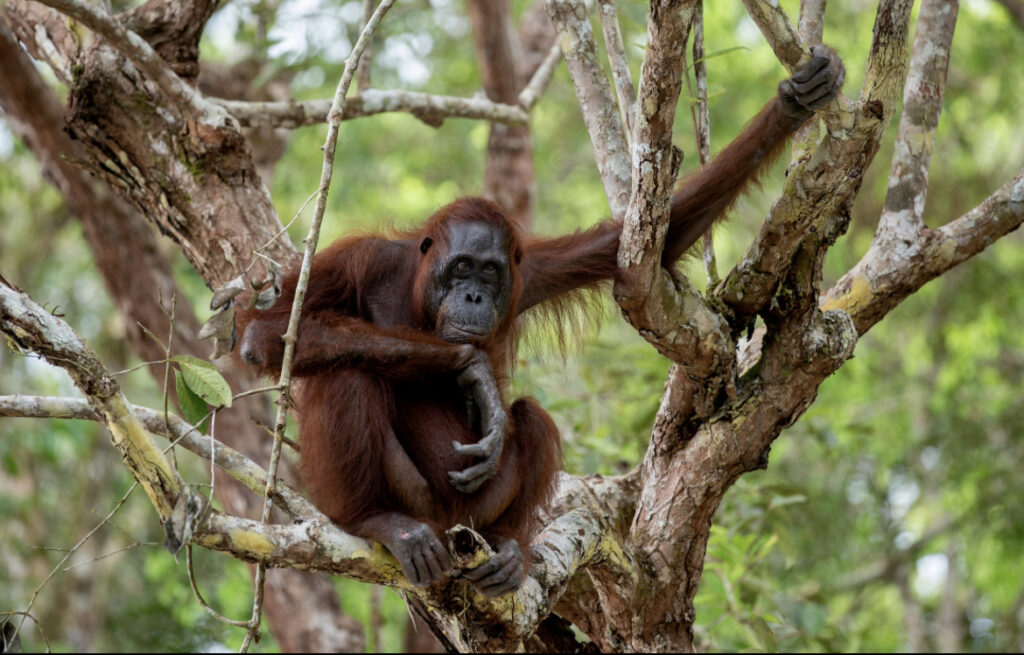
The babies of course are super adorable. Infants live with their mom for 5-8 years, learning everything they need to know for survival. This is why it’s particularly tragic to learn that countless babies are orphaned and if lucky they make it into the rehab centers to hopefully be re released later.
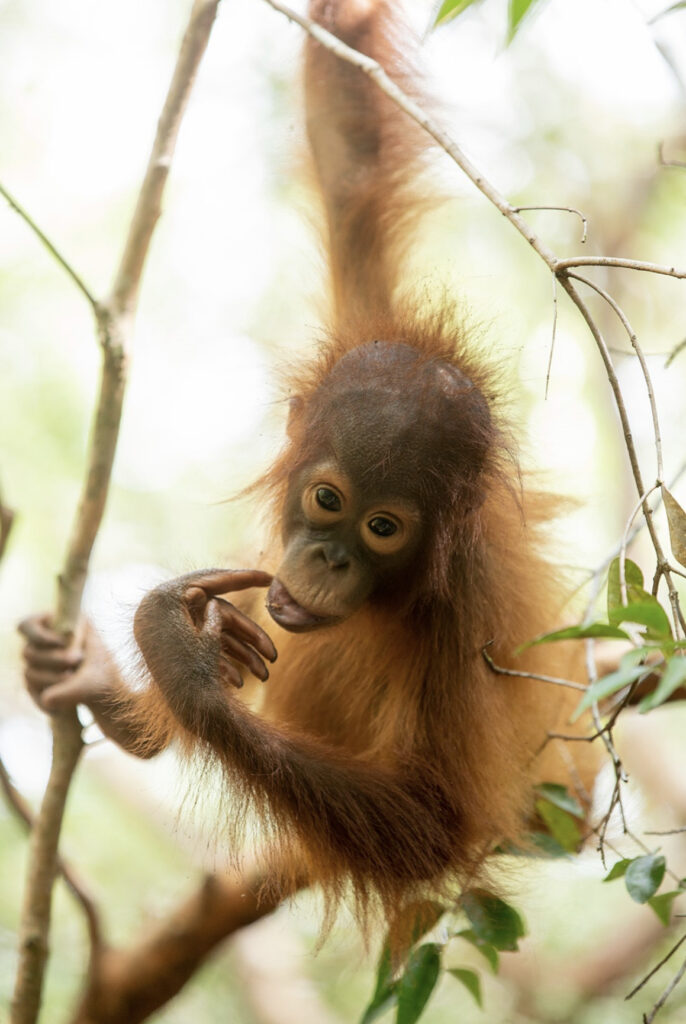
The feeding stations attract the orangutans which were previously in rehab, supplementing their diet especially when fruits are less abundant in the forest.
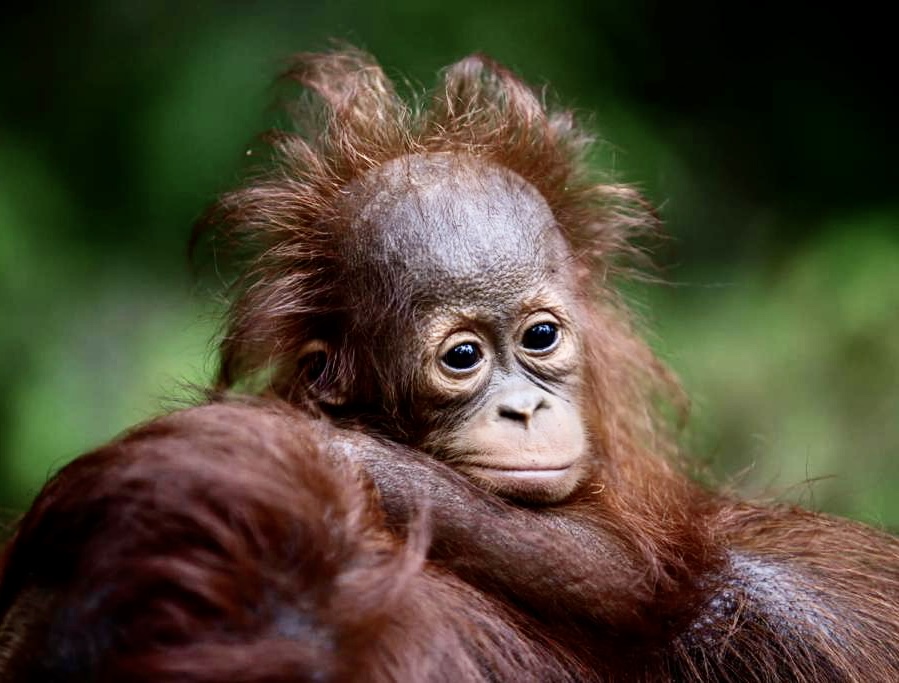
Here are 9 reputable NGOs that focus on caring for orphaned orangutans. You can “adopt” one for $12 a month and have impact in a meaningful way.
Specifically, your $ provides for vet care, enrichment and stimulation to develop skills, forest skills, nutritious food, bedding, play materials and resources for orangutan rescues , releases and habitat protection.
Most of these babies have often witnessed the brutal killing of their mothers before being sold through the illegal wildlife trade. (Before being rescued, if lucky).
🦧Borneo Orangutan Survival
🦧Save the Orangutan Foundation
🦧Orangutan Foundation
🦧The Orangutan Project
🦧Sumatran Orangutan Society
🦧Orangutan Conservancy
🦧Orangutan Foundation International
🦧Center for Great Apes
🦧Wild Think
We have just “adopted” 6 babies at “The Orangutan Project”… 1 for each of us and 1 for each of our sons!
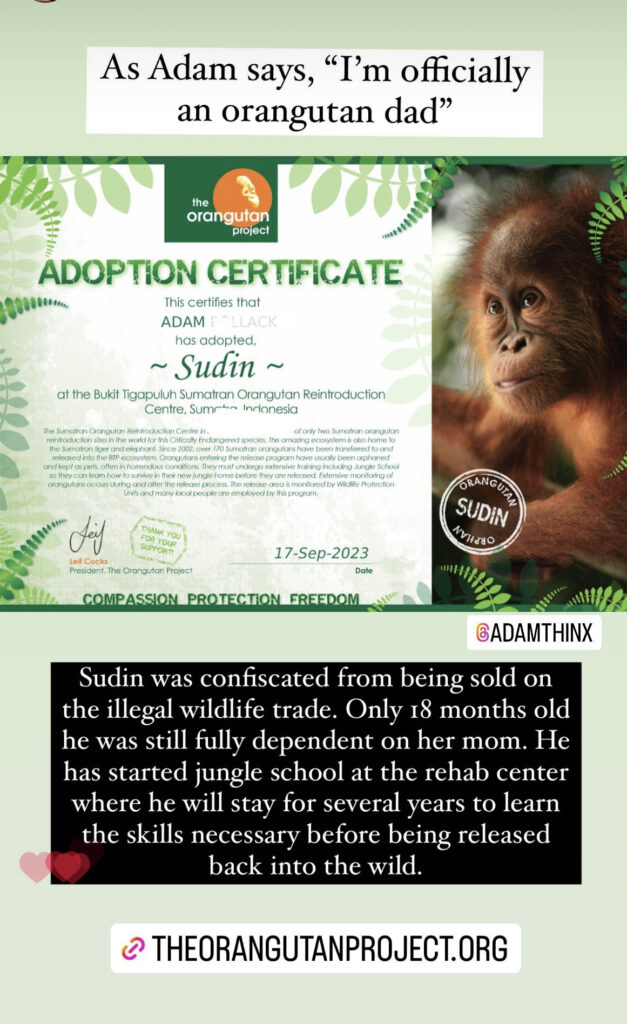
~~
After coming out of the jungle in Borneo, we have a day before our flights back to Bali, in the city of Pangkalangbun.
The call to prayer from the nearby mosques puts us in the right frame of mind to go exploring our neighborhood. A reminder that Indonesia is the largest Muslim country in the world. (Something one can easily not be conscious of in Bali, which is predominantly Hindu).
We head out in the direction of the mosque…
We meet the friendliest people, have many interesting interactions, including an in depth discussion with a young man who is genuinely confounded as to why foreigners come to see the orangutans. This evolves into a long conversation about conservation, the state of the forest and the disappearing population of orangutans and the causes, all of which are a surprise to him. Impact, one conversation at a time!
To our delight we run into a night market, that very Asian “invention” that makes so much sense ~ being able to shop for food after work and when the heat of the day has subsided.
Vendors are lined on both sides of a street, displaying an impressive array of locally grown veggies and fruits. Women mostly wear the local version of the hijab and are quick to chat…. Lots of smiles greet us as evidently there aren’t many foreigners roaming night markets in Pangkalanbun!
Strolling the market, checking out the produce and the characters. https://youtube.com/shorts/_-iFngxJXNQ?feature=share
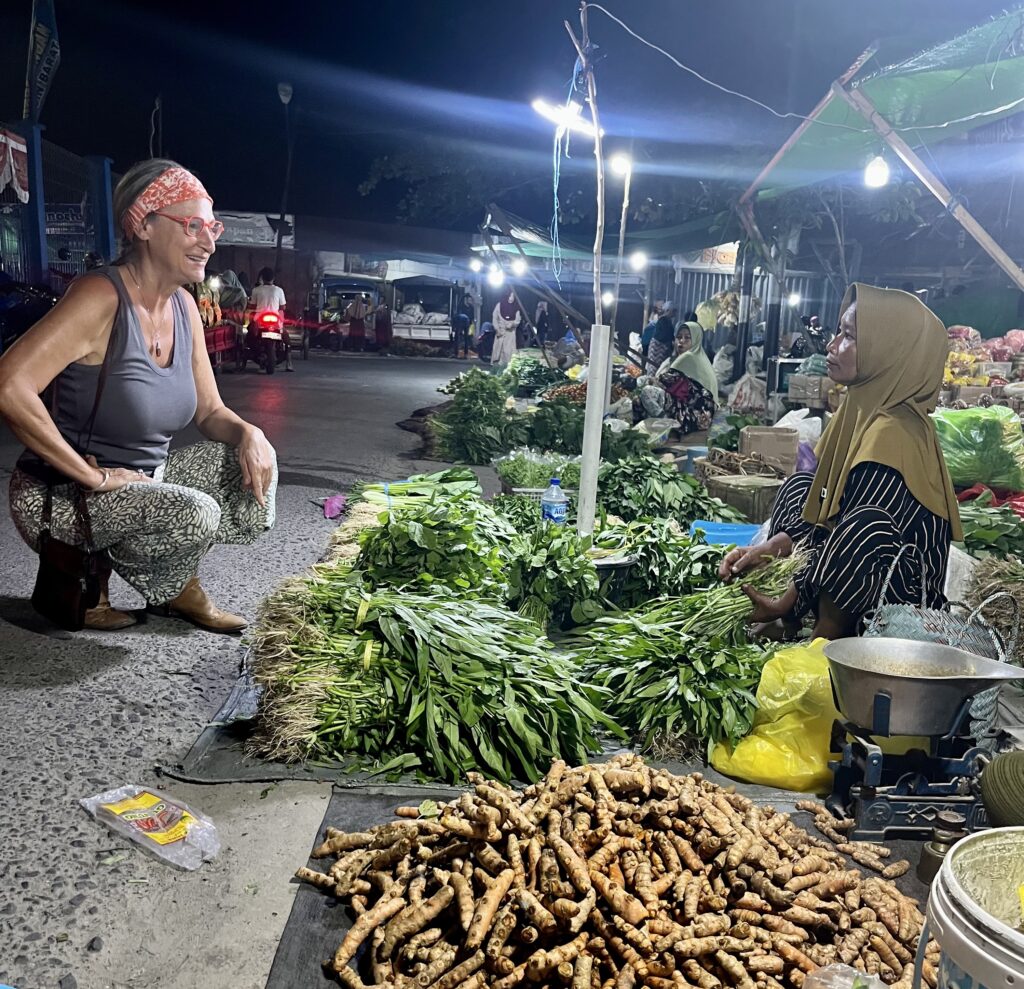
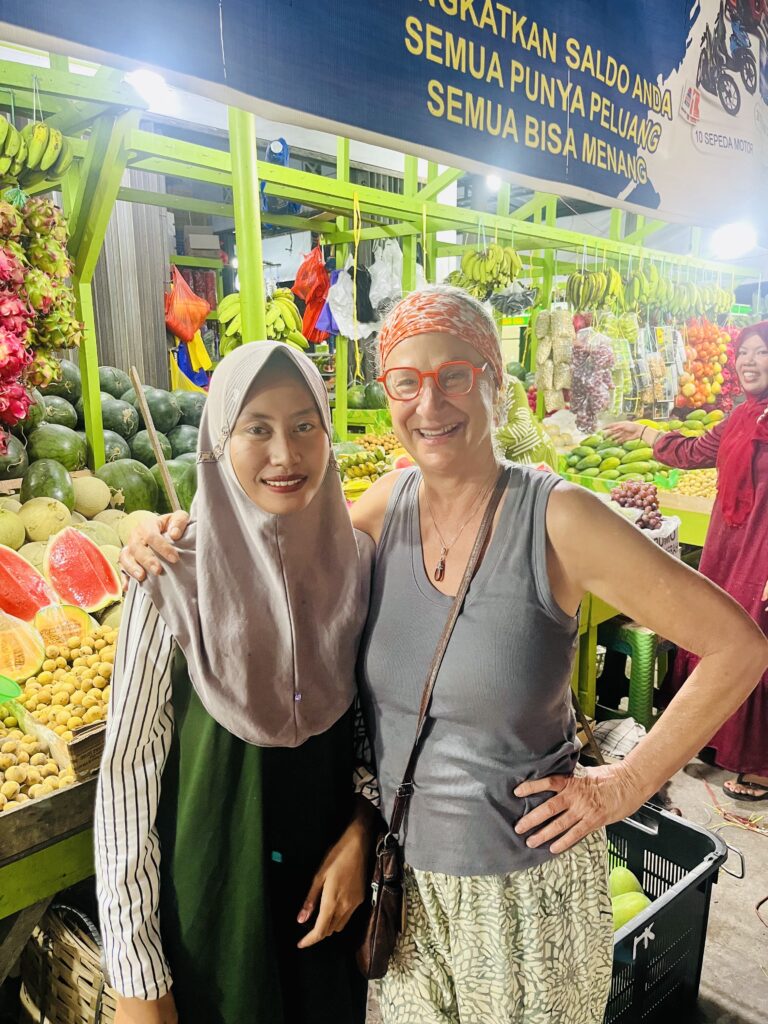
And of course where there is fresh produce and a night market, there must be street food…. Always a favorite with us.
Short video of street food being made, with sound track of mosque prayers reverberating through the market: https://www.youtube.com/shorts/CXwiTCNd8Gs
We start with some fresh corn cooked on a grill, and some fresh orange juice. We are searching for our main dish. We see a woman grinding tomatoes, spices, cucumber, chili and peanuts on a stone slab, making a dish from vegetables. A few men are hanging around chatting and clearly enjoying the food, and tell us to “sit down”.. so we do. Great choice!
While the cook grinds the peanuts, Ben spots some delicious looking fresh tofu nearby and asks the cook if we can buy some and add it to the dish. Of course yes. Weirdly, the tofu vendor could not speak a word of English, but looked at Ben and said “nihongo?” (which means, Japanese?) So in an absurb contradiction of cultures he and Ben had a long chat in Japanese. He had been a trader for a large Japanese company, in Indonesia, but now retired to pursue his calling as a tofu farmer.
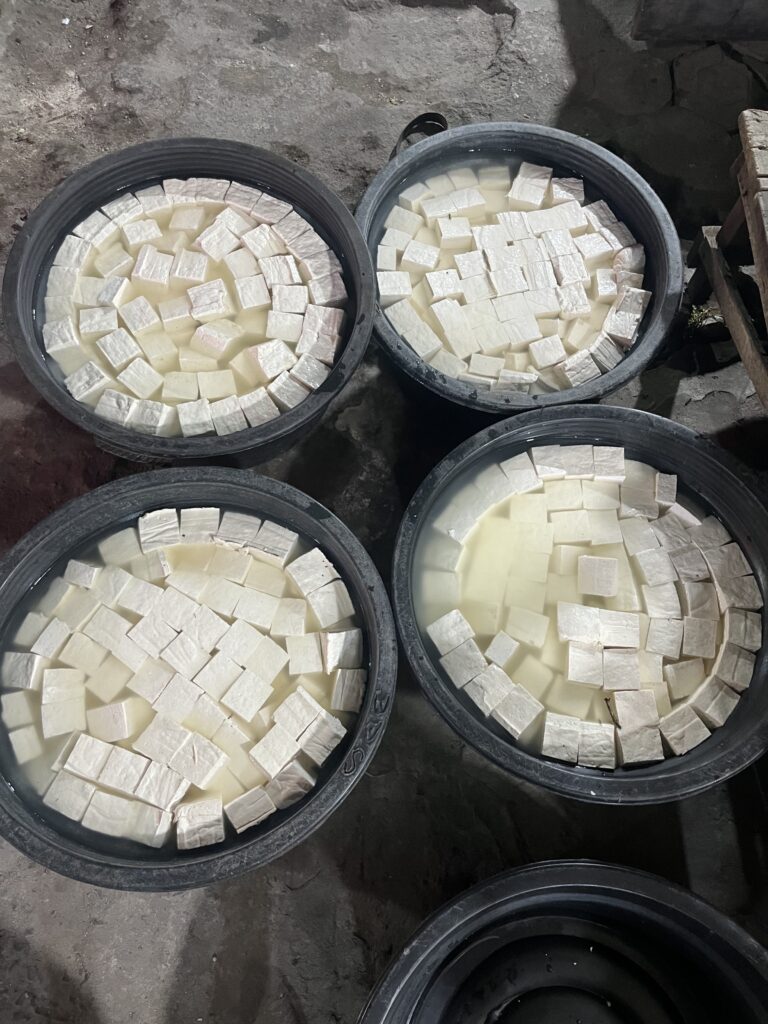
This meal was memorable! Simple and delicious ~ all fresh ingredients and made in front of us. A Kalimantan specialty.
This trip to Borneo to see the orangutangs in the wild was for us a once in a life time experience. So glad we were not put off by the amount of effort and energy it took to get there.
Gratitude to orangutantrekkingtours.com which organized our trip. Highly recommend for adventurous travelers.
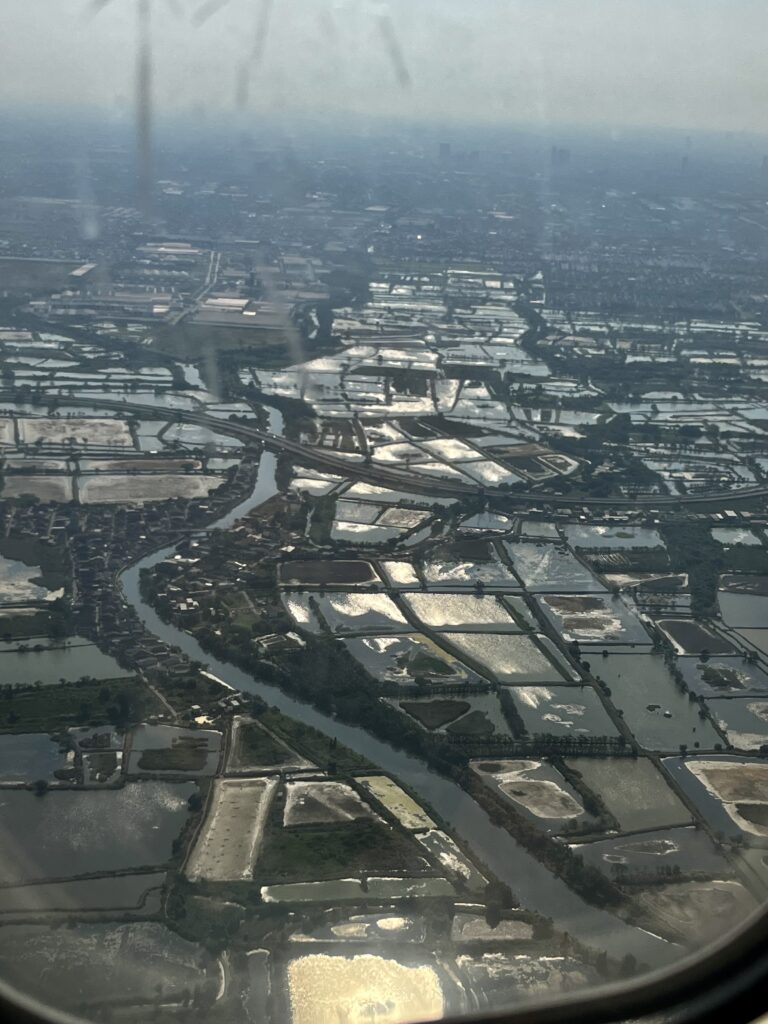
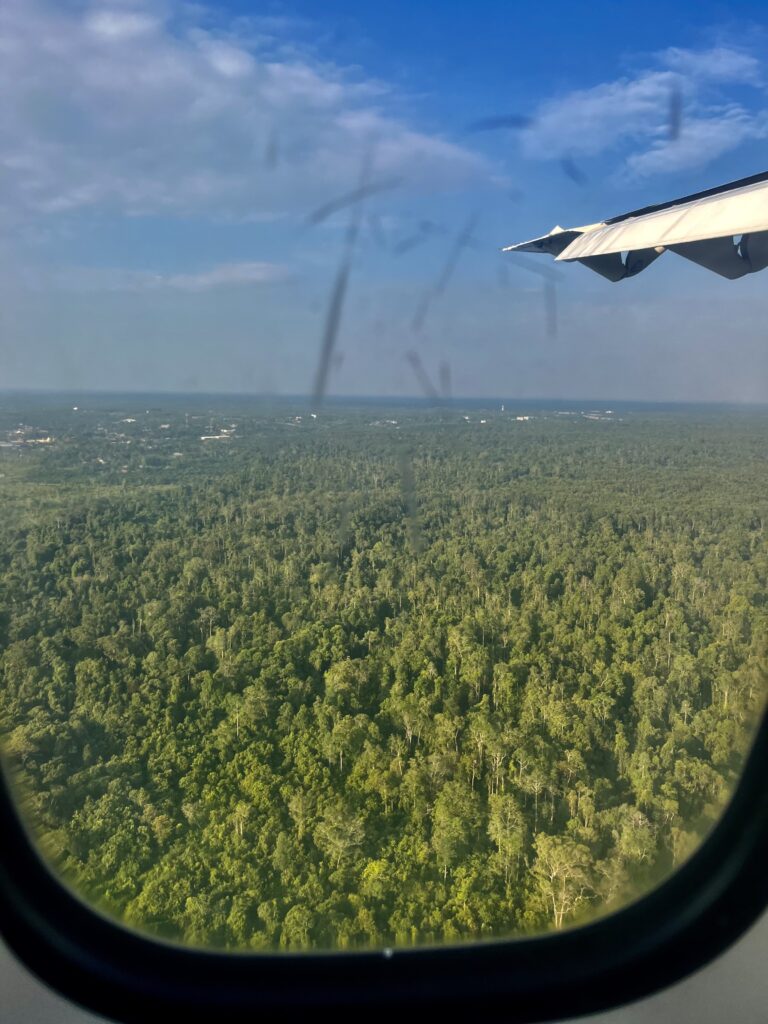
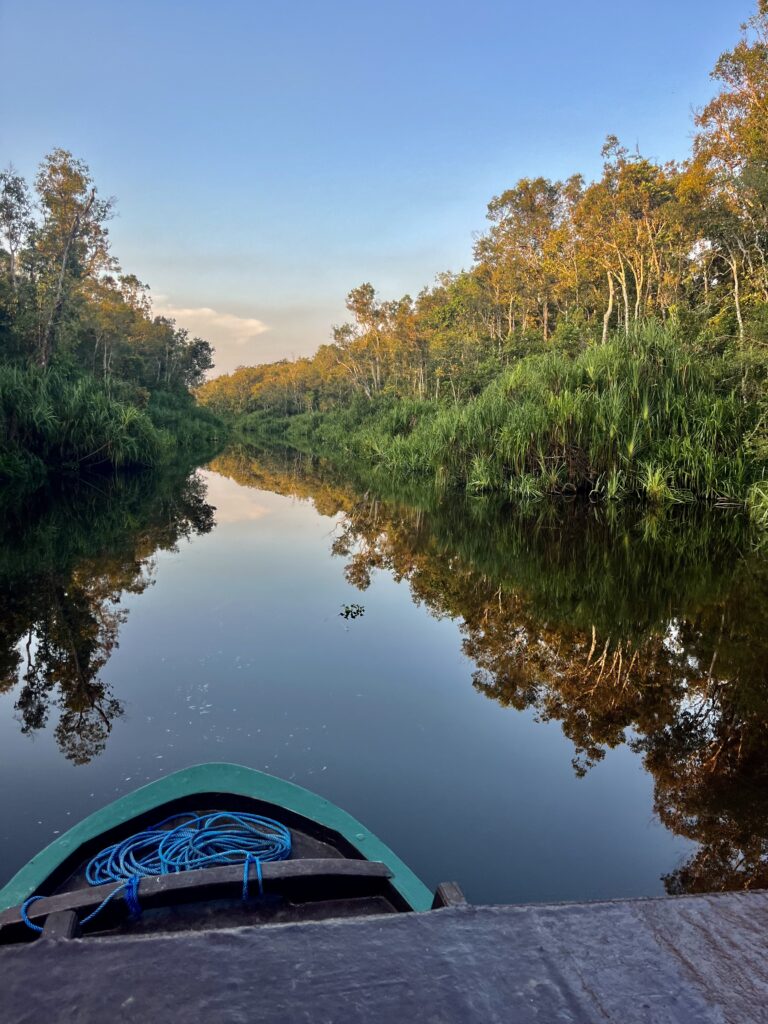
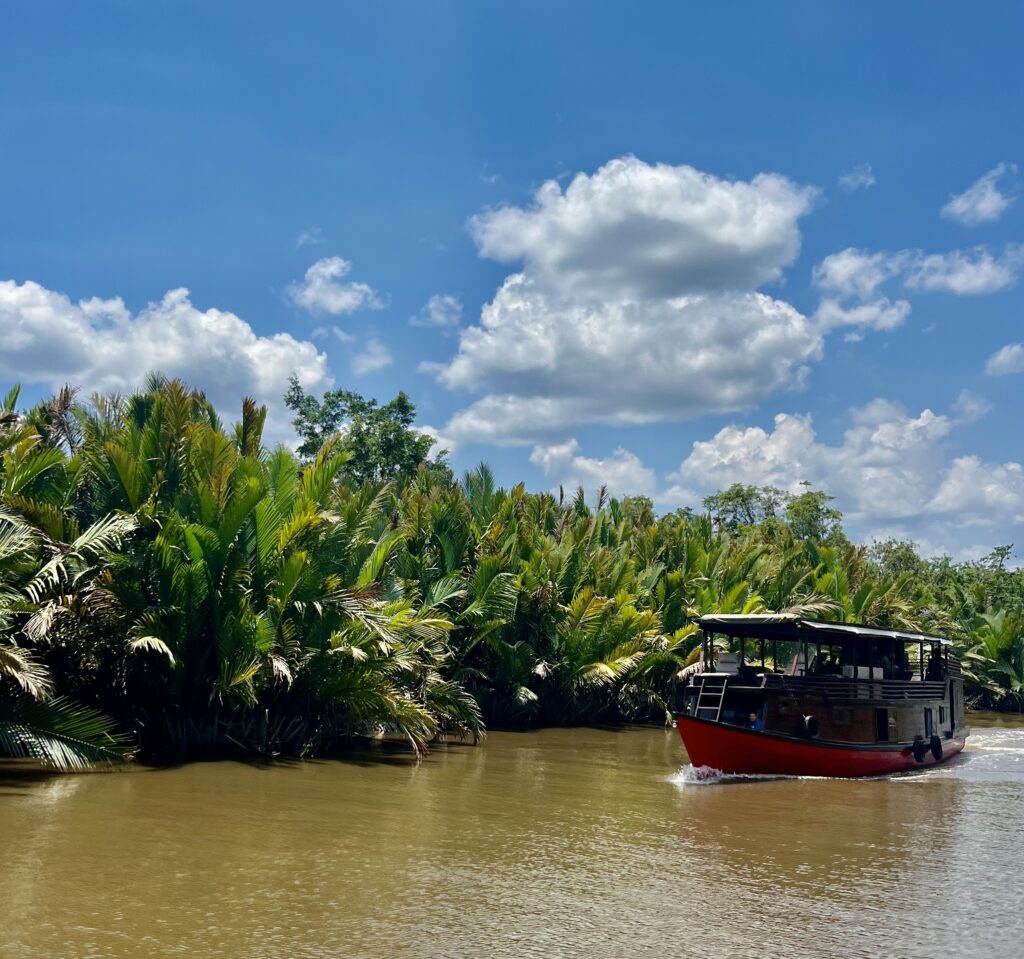
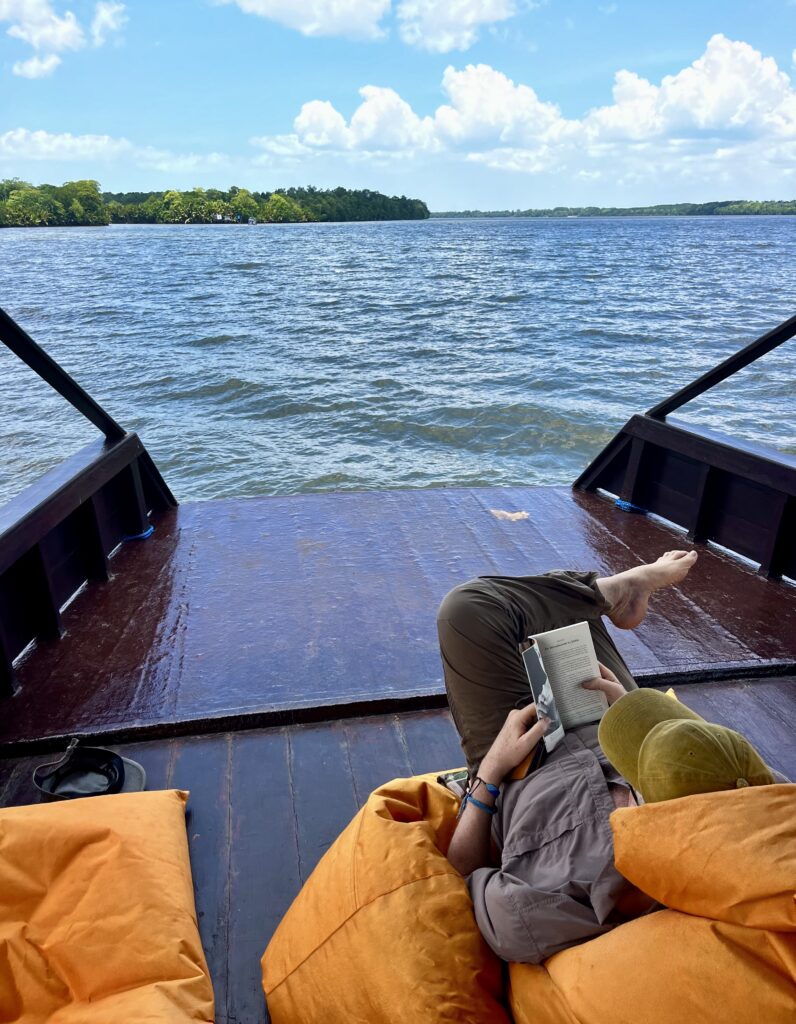
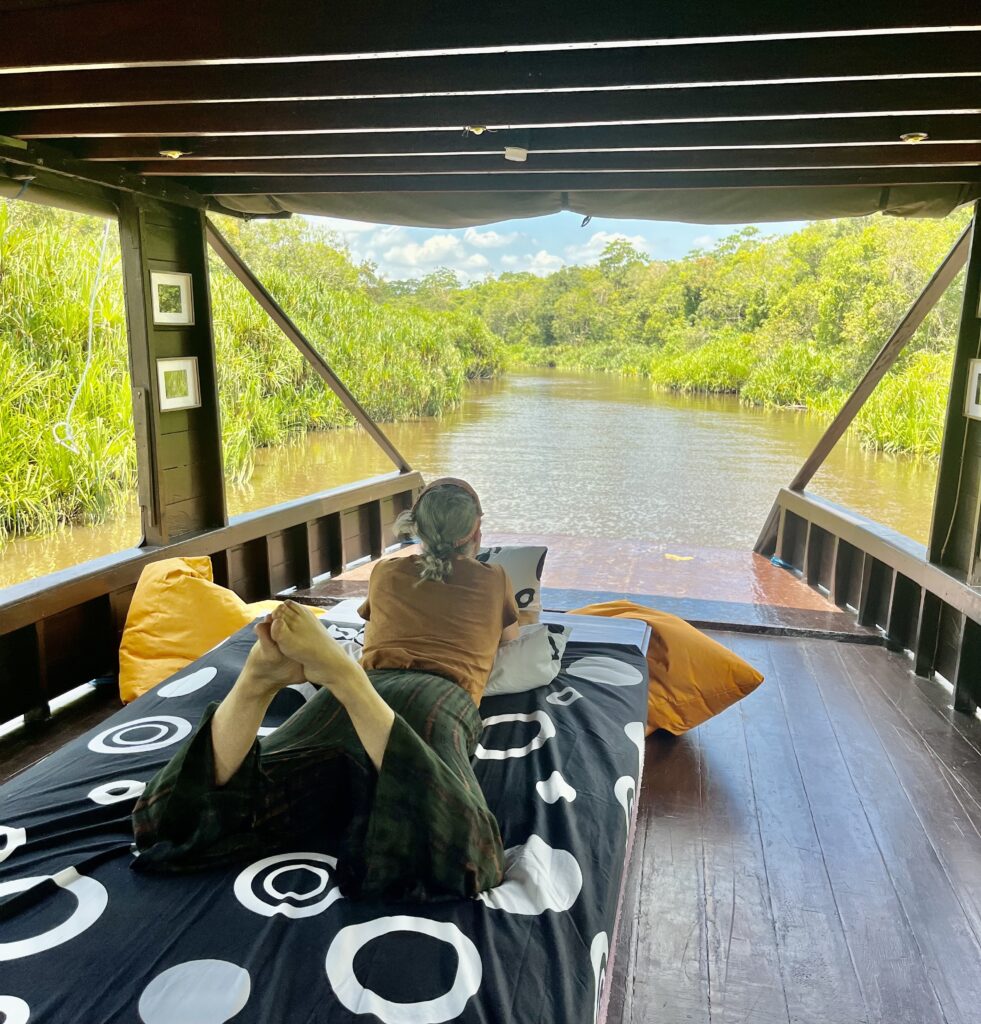
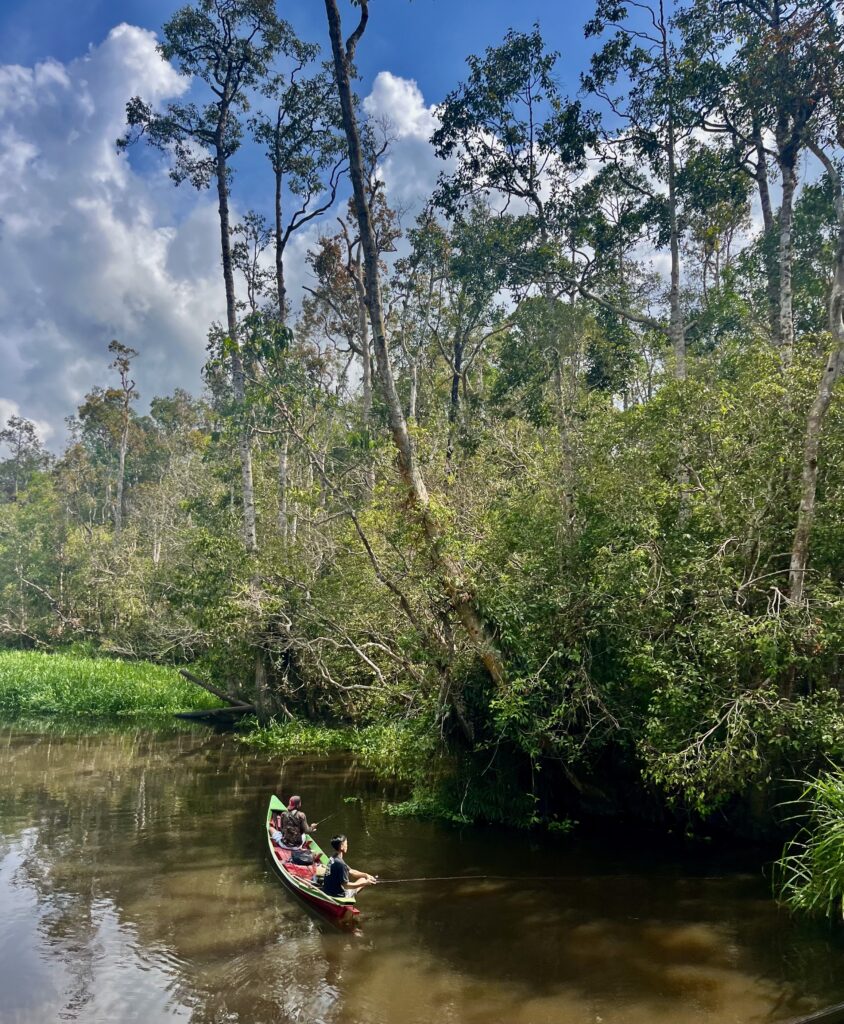
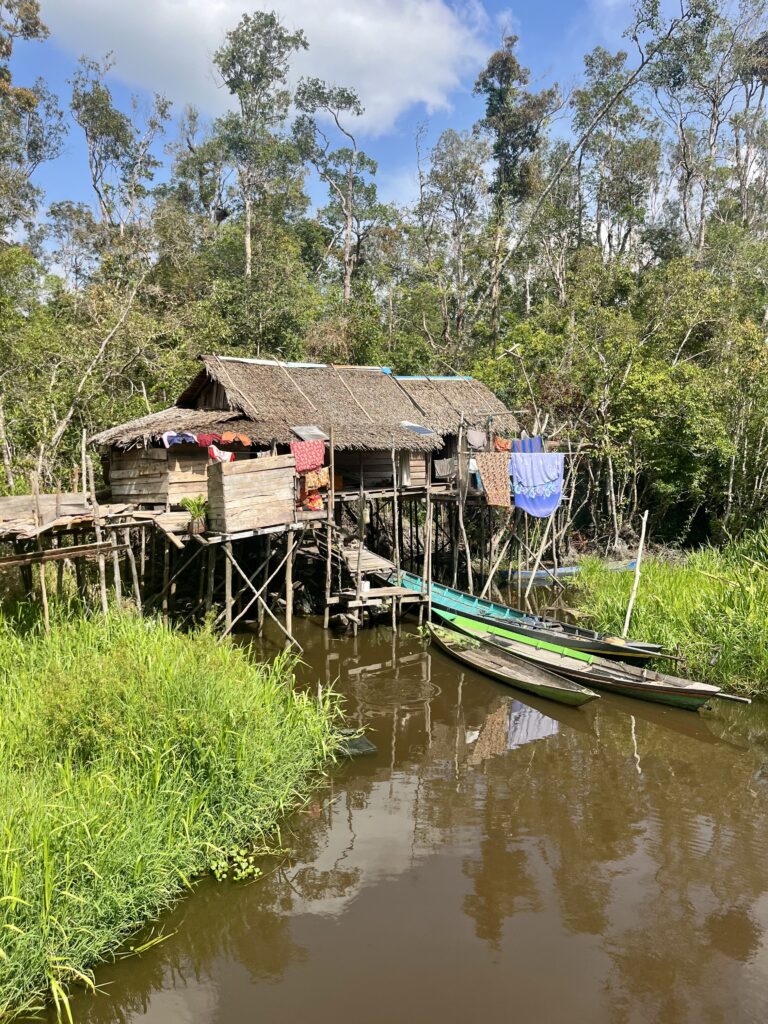
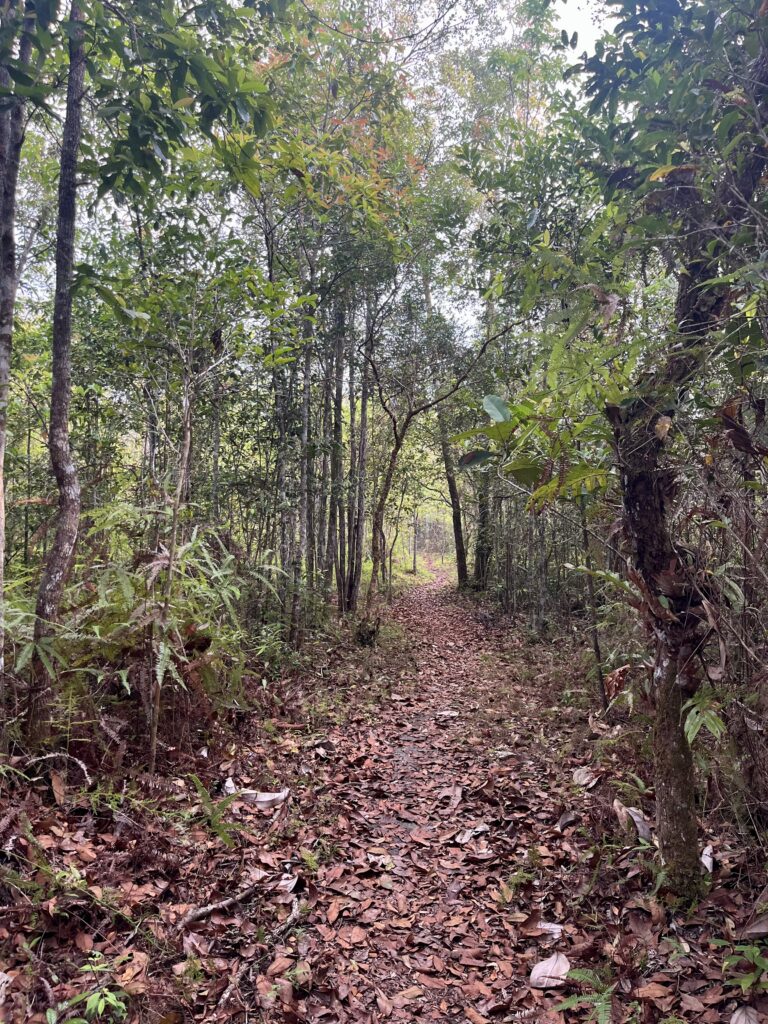
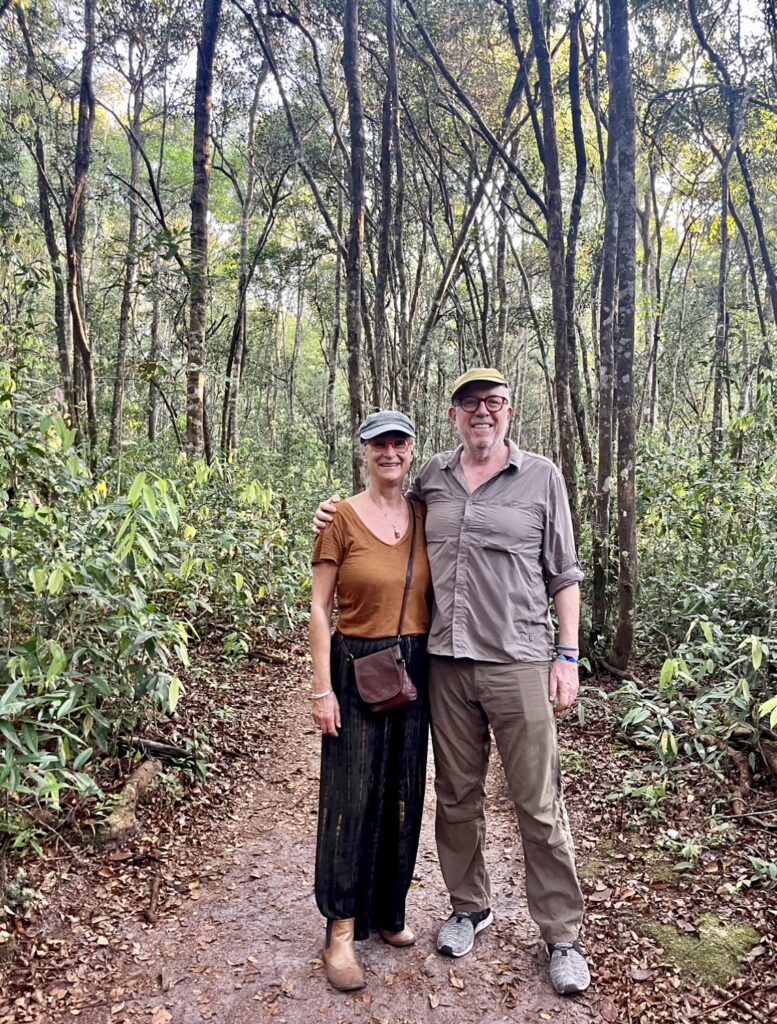
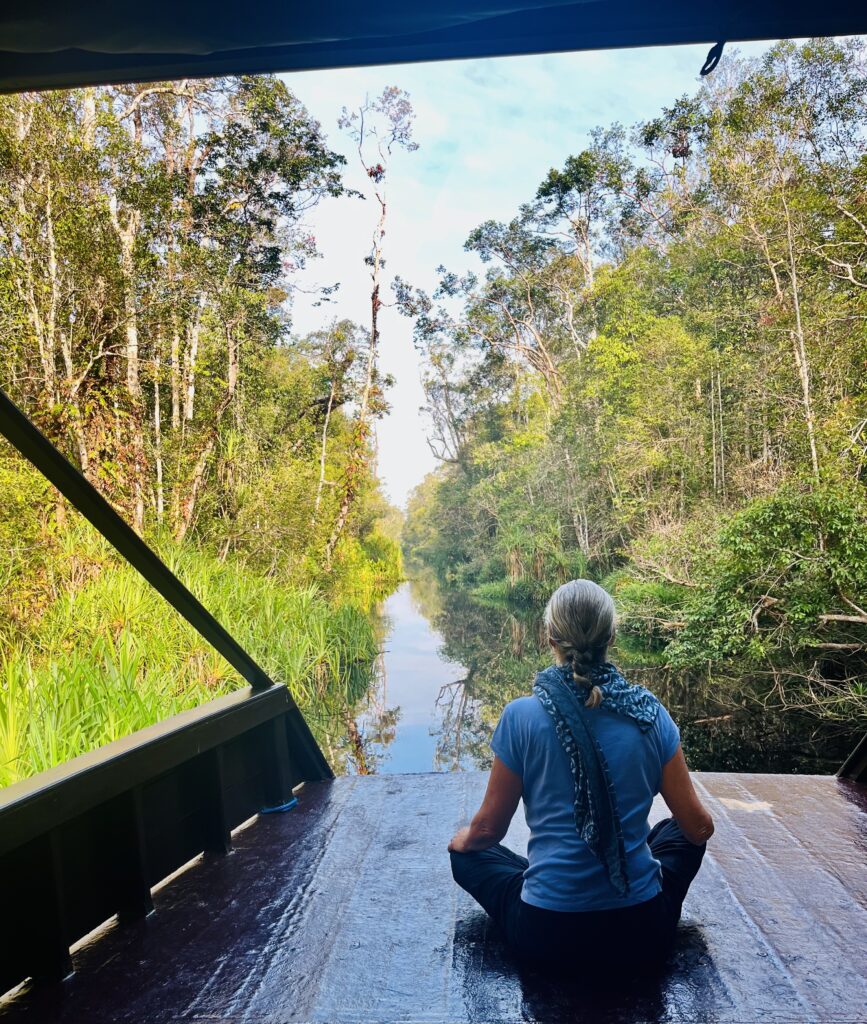
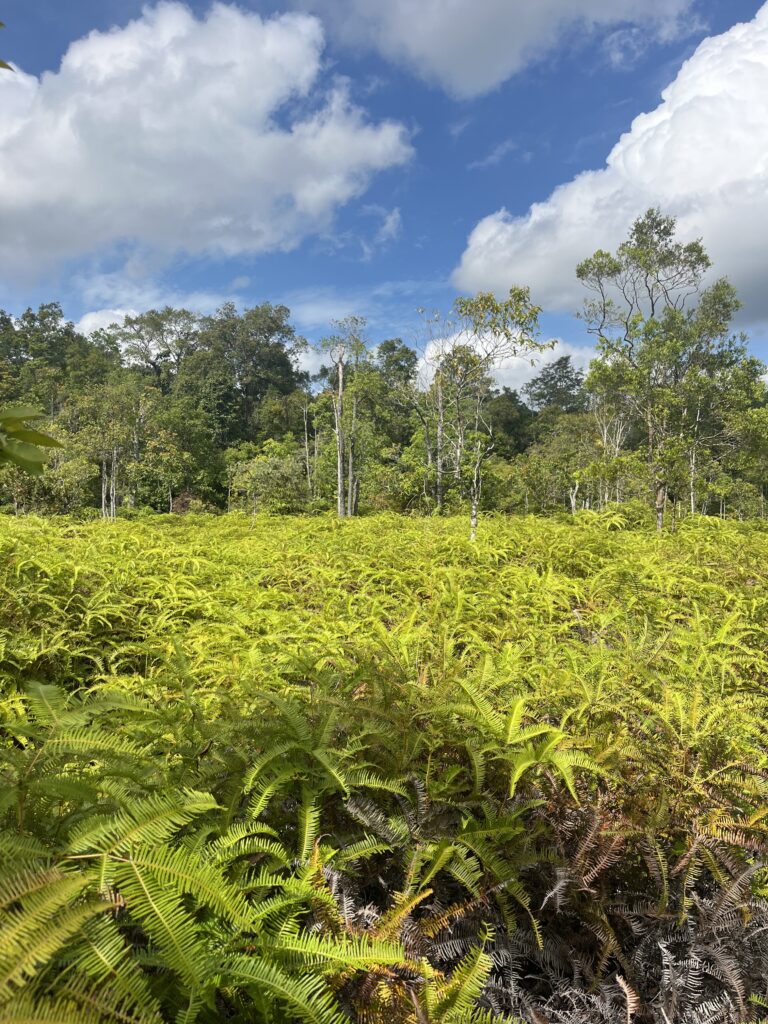
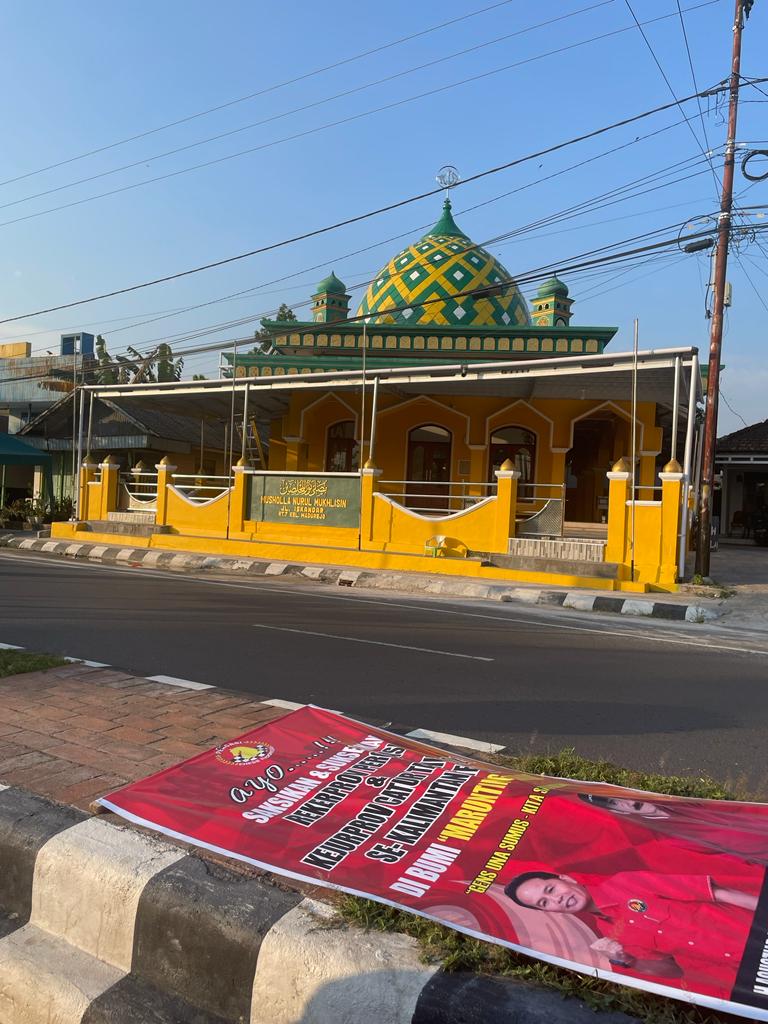
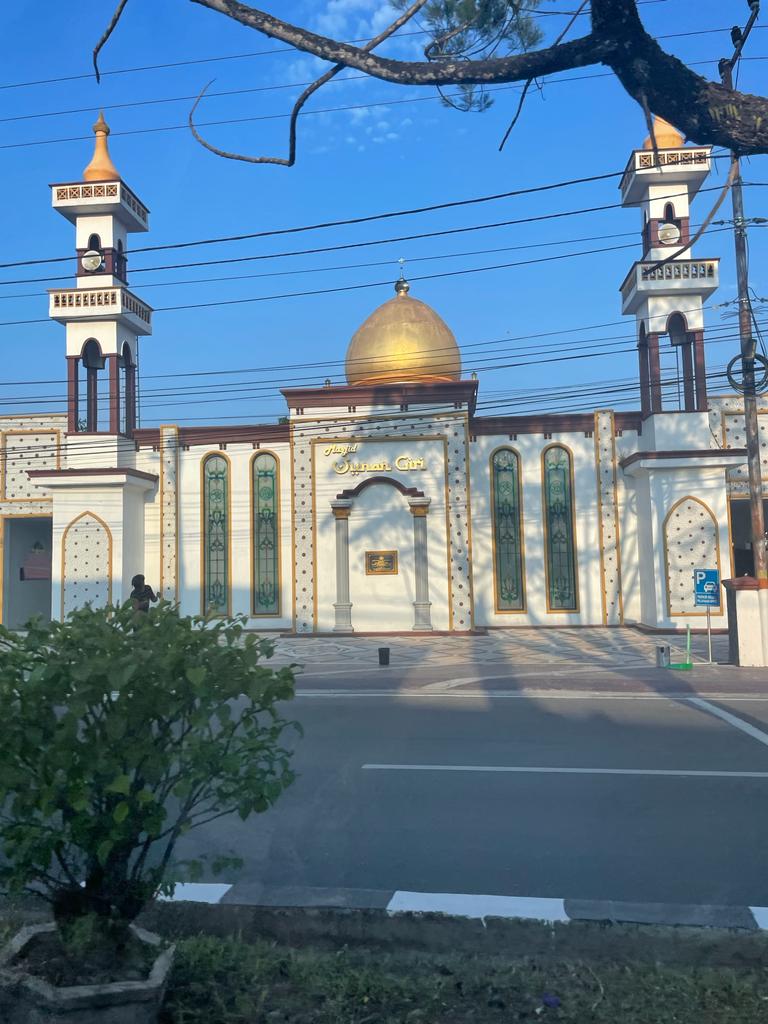
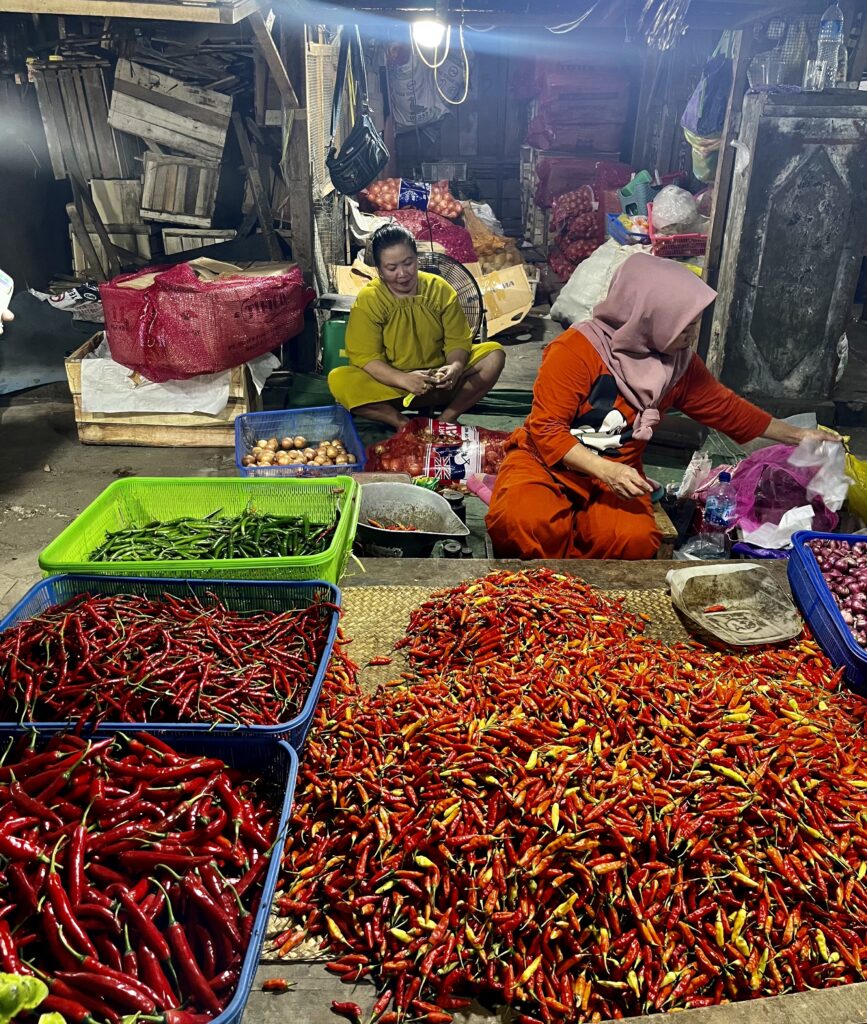
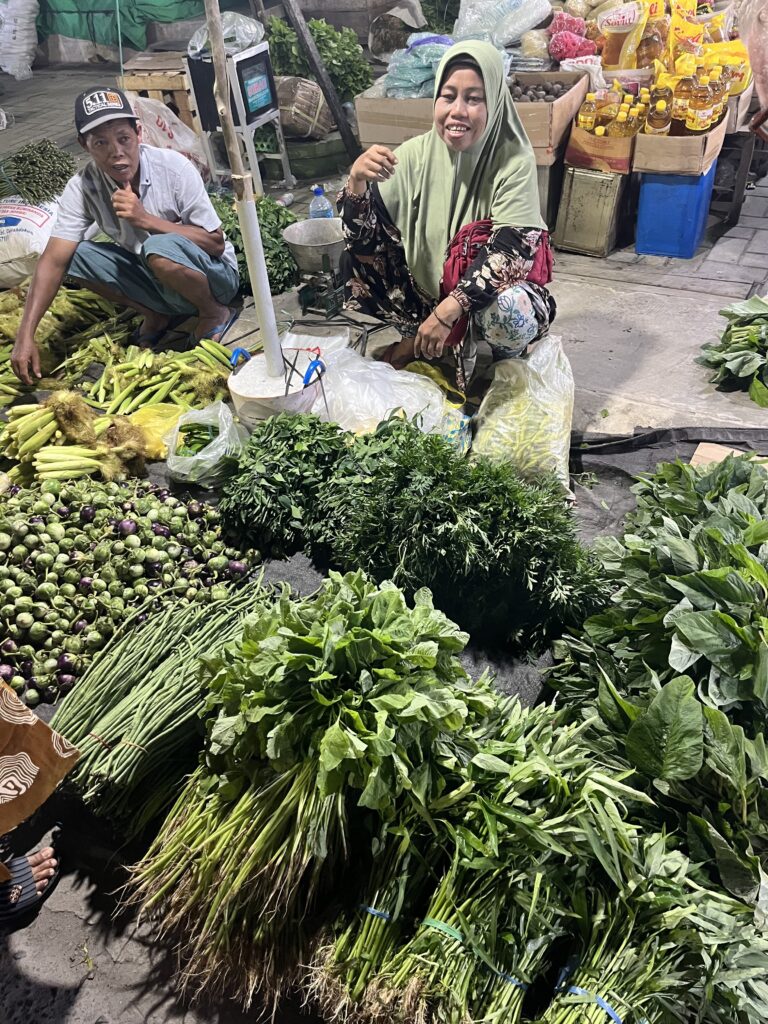
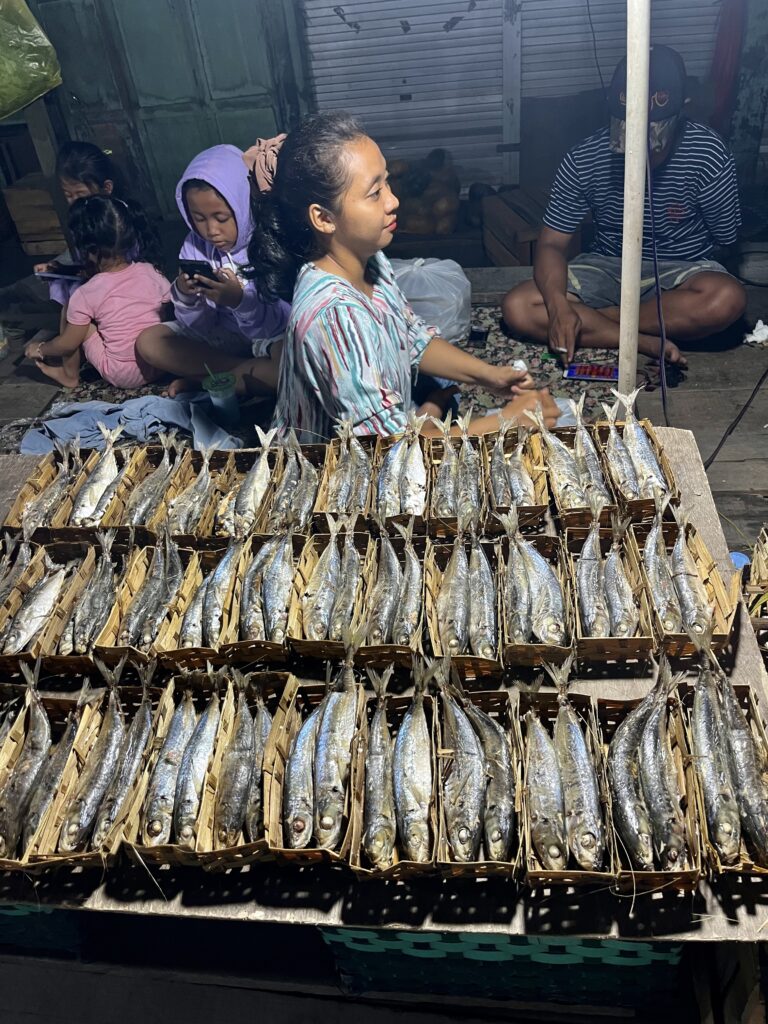
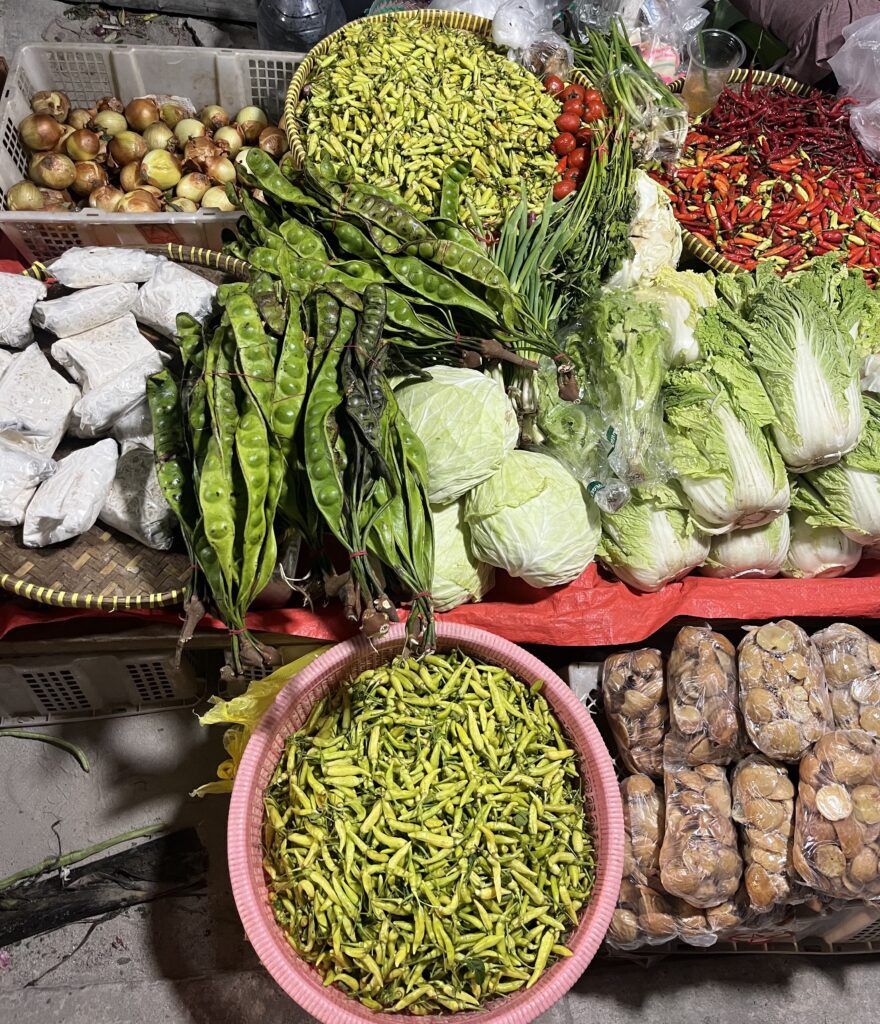
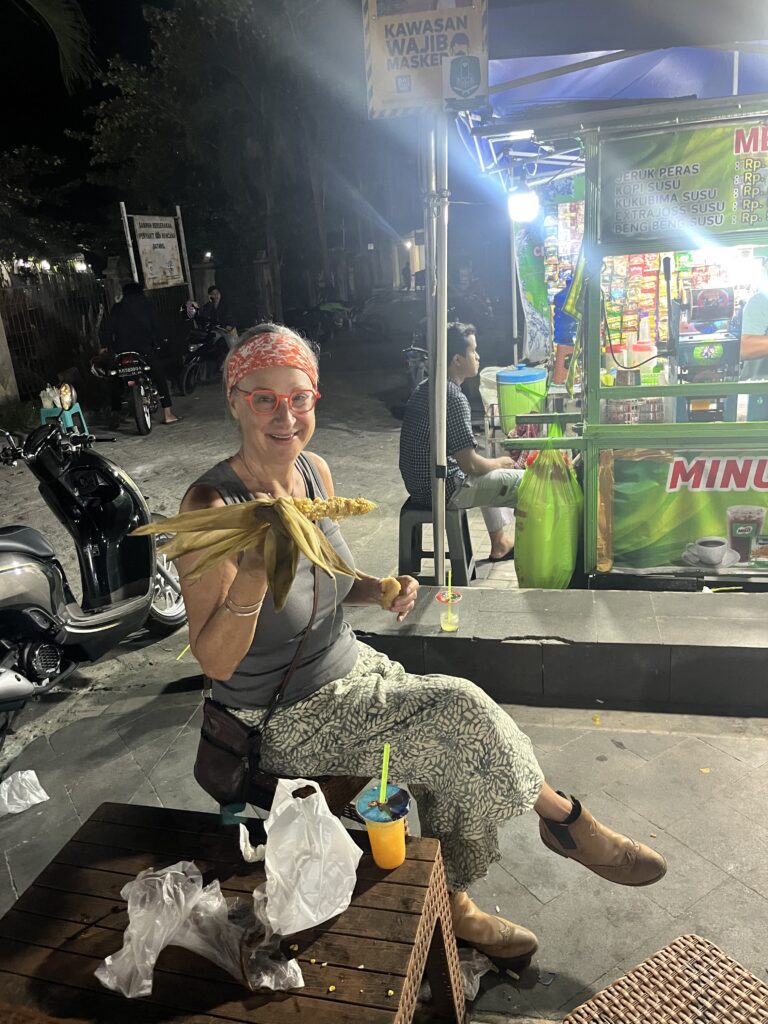
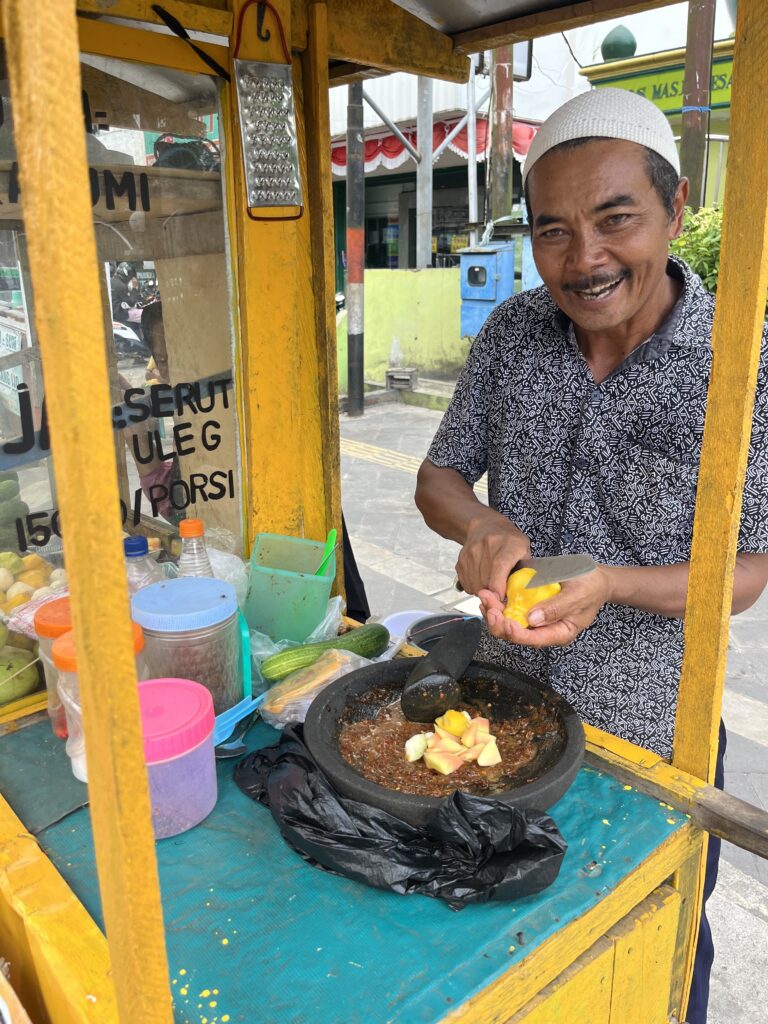
Now that’s a trip I’d like to undertake one day as well! So, the orangutans are wild, but they are fed at feeding stations? I understand that it’s supplemental to their natural diets, but who is in charge of feeding them?
I wish everyone knew the awful consequences of consuming palm oil! We always check ingredients to make sure the products we buy don’t contain palm oil. In some countries, this is easier than in others…
And how I wish there were night markets in San Pedro de Atacama, Chile, where we have been boiling in the desert for days! 🙂 Luckily, it does cool off at night to be able to sleep in our camper.
Hi Liesbet,
Thanks for reading and for your comments….
Yes the orangutans are wild, but over the last three decades an NGO that is dedicated to rescuing orangutans has built a network of three rehabilitation centers in the jungle which also provide food to those orangutans who have been released back into the wild and who in times of food shortages, know that they have a reliable food source at the feeding stations.
For example there are many babies whose mothers have been killed either by poachers or the palm oil industry teams on the ground. The habitat is also continuously shrinking thereby impacting the food source.
Once one starts looking at labels it is quite shocking to see how many products in so many different sectors contain palm oil.
Realistically it is actually quite hard to spot wild orangutans without spending days trekking, we did manage to see a few. But the best way to see them is when the food is put out onto the platforms at regular times. The orangutans slowly emerge through the thick foliage to feast on the food provided for them.
Ah that night market was spectacular. Both in the quality and volume of produce and the friendliness of the people.
We have to catch up with your travels. But good to read you are still in S America and faring well.
Peta & Ben
Thanks for the explanation and details! I’d love to see those beauties in the wild one day. In Kalimantan. 🙂
You guys continue to amaze and delight. Thank you for enlightening me regarding Palm oil. I will be careful to read labels in the future. 98% DNA match makes sense. Did you see that look on the big guy’s face? Great photo btw. This is not a trip I will likely ever take, so from the bottom of my heart, thank you for sharing.
Thank you Suzanne for such a lovely positive comment. We are very happy to share our experiences and photos and so glad that you enjoyed this post so much.
If you are on instagram then we do tend to have more updated posts there… but as you can see, we are doing our best to catch up here on the blog, to the present.
Peta
It was so wonderful to travel vicariously with you on this journey. What an amazing time you had. It reminded me of our all too brief time at the rehab centre in Sepilok, Malaysia. They are such magnificent creatures. I hope they can be saved.
Alison thanks for your comments. Interestingly we almost went to that rehab center but at the time it was the rainy season and we decided against it.
Amazing creatures indeed. Sadly, they are endangered. Only three locations left, one is almost depleted with only 800 individuals left. Their future does not look bright. Then again almost all wildlife is under similar threat. With the spread of agriculture, farms and reduction of natural habitat the result has been disastrous for wildlife. We saw this as well first hand with the elephants in Sri Lanka. Very tragic situation.
P
Peta and Ben, I am so glad you have managed to fulfill your dream of visiting these magnificent creatures. Loving your photos and travelling vicariously with you. I always check labels and try to avoid Palm Oil, although not always easy. It is sad to see so much of the jungle has already been lost. The boat trip looked so beautiful and peaceful.
Hi Gilda, so nice to hear from you.
Yes, sadly palm oil is prevalent in so many different products. If only more people were conscious about their shopping choices, and anything with palm oil was boycotted, then perhaps we could start to see some real change. But short of that, and that is not likely, there future is very bleak. Its a tragic situation.
P
I need help and ideas to start a new website?